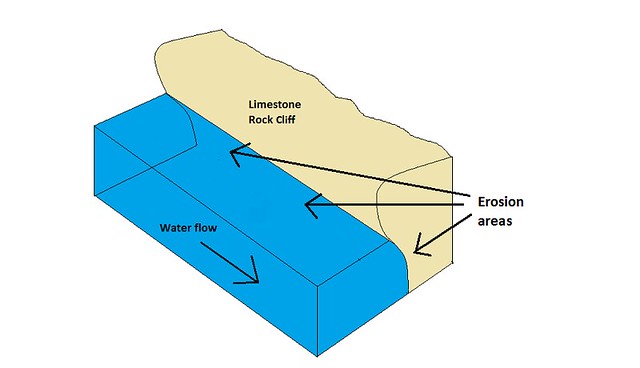Although this earthcache is focused on the cliffs in the quarry area I will provide information about the cave and the quarry for completeness and because the formation of both are identical.
History/Myths and Legends
There is a rich history of myth and legend surrounding the area. It is thought that the cave has been occupied since at least the Upper Palaeolithic era due to the flint tools found together with remains of wholly mammoth, rhino, bear and lion, however it may well have been used before this but evidence of this would have been eradicated by pre-Palaeolithic ice flows. A hearth thought to be from about 12,000 years ago was also found close to the entrance.
In 1695 a skeleton of a 'giant human' was found in the cave, however this story is difficult to verify as the story goes that the owner of the bones, a local surgeon called Mr Pye took them with him on a trip to Jamaica (!) and they were lost to the sea when the boat he was on sank.
As to the origins of the name, this is a bit uncertain as there are numerous myths and legends surrounding the cave but none directly relate to King Arthur apart from the story that the aforementioned bones were possibly his! But it is difficult to know whether the bones gave rise to the name or the name gave rise to the story. The most enduring story is that the native British king, King Vortigern, had a number of troops hidden in the cave when he was fighting the Anglo-Saxons but the numbers were meant to be in their hundreds - rather a lot for the size of cave.
The Geology
The limestone rocks at the quarry and cliff face (and cave) date from the Carboniferous period when this whole area was under a shallow and warm tropical sea, situated, as it was, much closer to the equator than it is now. At the time England and Wales were part of a larger land mass known as Laurasia. Laurasia was the northern sub continent that was formed after the break-up of the super-continent Pangaea (it's southern counterpart being known as Gondwana).
The sea would have been full of life, and, as these creatures died, their bodies sank to the bottom of the shallow sea and over time layers and layers of calcium-rich shells built up, were compressed, and eventually formed the limestone now present.
Over the years this land slowly rose to reach the elevation it is today and at some point a river flowed along the base of the cliff which was critical in the formation of the caves - essentially only two things are needed for this type of cave formation, water and rock. However the rock must be dissolvable, in this case limestone. The mechanism of action is simple really - as the water flows past it dissolves the stone and takes away the solute, and as time goes by nooks and crannies would have been created, then enlarged by the water and enlarged some more until the caves we see today were formed. Therefore these caves are known as solutional caves.
On closer inspection at the published co-ordinates you will notice that the caves are more like curves worn into the base of the cliff. This was where the level of the river was as it flowed past and dissolved and eroded the cliff face, as shown in my simplistic diagram below:

Visiting
The quarry and cave are situated near Symond's Yat West and Doward and are easily accessed from the A40 Monmouth/Ross-on-Wye dual carriageway. Come off this road at either of the Ganarew or Whitchurch/Symond's Yat West junctions.
The stated co-ordinates take you to the middle of the cliff face where this earthcache is situated. The easiest way to visit is to park at the space for a couple of cars to the north (waymarked for you) and just wander down the public footpath marked on Ordnance Survey mapping. If you want to visit the cave afterwards (and why wouldn't you!) just continue down the footpath a bit further.
The Tasks
To log this earthcache you will need to visit the co-ordinates, as stated, and send the answers to me to the questions below:
1) I mentioned the Carboniferous period earlier, but how long ago was this?
2) Take a close look at the limestone - can you see any fossil evidence? If yes, describe it, if no, why is this?
3) What height does the curve of the limestone reach and what does this tell you about the height of the river?
4) Look at the rock surface in the curve and above it. Are they the same or different? Describe them.
5) Bearing in mind your answer to task 4 - explain why this would be.
You do not need to wait until I reply to log your find, but I will come back to you to either confirm or clarify your answers as soon as I can. Photos are always appreciated too of course but are not a condition of logging.

| I have earned GSA's highest level: |
 |
Many thanks to the Herefordshire Wildlife Trust for allowing me to place this earthcache here.